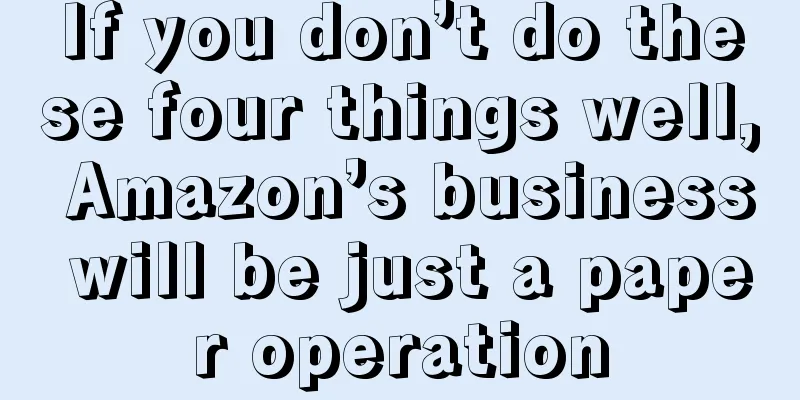If you don’t do these four things well, Amazon’s business will be just a paper operation

|
To win in the long run on Amazon, you need to do these four key things:
If you do these four things well, your product rankings and revenue will rise steadily. 1. Purchase inventory strategically Before you expand your product inventory and purchase in bulk from a manufacturer, think carefully. It is very important to conduct product selection analysis on potential products to avoid problems such as the final product being unsaleable or the quality being unreliable, which will force you to clear out your inventory early. Here are the key factors to consider when buying inventory: 1) Sales ranking There are two types of ASINs you should be aware of:
Sellers don’t have to worry about not being able to sell products with high sales rankings, because high rankings mean that products are popular and consumers are more likely to buy them. As for products with almost no sales rankings, sellers can open up new markets and become market leaders. 2) Product Reviews Pay attention to product reviews. More customer reviews are good for your product. Accumulate more positive reviews, and don't let 1-2 negative reviews ruin all your efforts. But sometimes, negative reviews have nothing to do with your product itself, but are given by customers who didn't read the product description carefully. 3) FBA status Products that are not shipped by FBA are an opportunity, but you need to investigate why this product does not use FBA, because some products cannot be shipped using FBA. 4) Price Fluctuation Check the historical prices of the product. If the historical prices have increased or decreased significantly, you should be prepared to respond and avoid risks during the same period. 5) Competitors Check how many competitors there are for a particular product. This is known as Amazon market depth. If there aren’t many competitors selling that product, then you’re likely to be the market leader. If there are a lot of sellers for a particular product, then it means there’s a high demand for that product, and you’re likely to be able to grab a piece of that market. 6) Amazon search ranking The order in which products appear on the search results page reflects the product ranking. Ranking high or low has unique opportunities and challenges, and it all depends on your Amazon SEO optimization strategy. For highly ranked products, you can capitalize on their already successful market position to make money, while for lower ranked products, you have ample room to grow into a major seller in that market segment. 7) Product categories Maybe you are currently focusing on selling only one category of products, and the market performance is good. But if you want to expand the market, you should take some risks and try other categories. At the beginning, it may be easier to start with related categories that you are currently selling. 2. Develop different strategies for products As your store grows, it can be difficult to develop a marketing strategy for each product. At this time, applying the "universal template" will no longer solve the problem. At this time, the most effective way is to focus your energy on the best-selling products in your store. Four steps to develop different strategies for products: 1) Choose a profit strategy Start by asking yourself these two questions: Is my business profitable or unprofitable? Do I want to change that or keep it the same? It is crucial for sellers to have a clear picture of their business for future decision making. 2) Choose a replenishment strategy Based on the sales cycle of the product, determine whether it needs to be replenished on time for a long time or in small quantities or even without replenishment. 3) Determine the seasonality of the product Understand the length of the product's sales cycle and determine whether it is a seasonal product so as to choose an appropriate replenishment strategy. 4) Pay attention to the clearance requirements If you are an Amazon FBA seller, you need to consider that Amazon charges additional fees for storing items that are older than six months. Plan ahead to clear out your inventory so you don’t have to pay extra. If the product doesn’t sell and you have too much inventory, you can either mark it down or have Amazon refund it to you. 3. Amazon delivery methods: FBA and FBM For sellers who want to expand their business, there are two shipping options:
1) FBA Amazon third-party sellers can use the FBA delivery service to prepare goods in advance and transfer them to Amazon warehouses. Amazon's one-stop logistics service covers warehousing, picking, packaging, delivery, payment, customer service and return processing. Benefits of using FBA for delivery:
FBA Disadvantages:
2) FBM Amazon FBM advantages :
FBM Disadvantages:
4. Choose the right repricing method As your business expands, the question you face now is not whether you should reprice your products. After all, 60% of mid-to-large Amazon sellers (those with revenues between $2.5 million and $10 million) reprice their products at some point, highlighting how important repricing is to growing your business. Repricing method: 1) Manual Repricing As the name suggests, manual repricing means that sellers manually adjust the price of each product one by one. Manual repricing is not a good repricing method. This method is only suitable for small sellers with limited funds and manageable inventory. Now that you have decided to expand your business, it is time to skip this method. 2) Rule-based repricing The most commonly used repricing tool for Amazon sellers is the rule-based repricing tool. For example, you set a price rule: the price is within the 10% lowest price range, and then the tool will reprice according to the competitor's price. However, one of the biggest problems with rule-based repricing tools is that they can trigger price wars and ultimately weaken sellers’ profits. This is unwise because sellers with high customer satisfaction ratings often have higher prices than their competitors and still win the Buy Box. 3) Algorithmic repricing Like rules-based repricing, an algorithmic repricer is a tool designed to automate repricing. The difference is that algorithmic repricing is a set of performance indicators that evaluate sellers who win the Buy Box using big data. The results of this repricing are highly accurate and profit-maximizing. You don't have to gain a competitive advantage by lowering prices, nor do you have to worry about not recovering costs. Although the initial cost of algorithmic repricing tools is higher, it will win you more benefits. As the seller's business grows, you can try algorithmic repricing tools. 10 Best Automated Repricing Tools for Amazon Sellers
(For details, please see previous articles in the official account) |
<<: Explore the successful path of private label sellers to earn tens of millions per year
>>: Amazon Business Cost Analysis and How to Maximize Your Profits
Recommend
What is the Weisuyi Supply Chain Platform? Weisuyi Supply Chain Platform Review
Guangdong Weisuyi Supply Chain Management Co., Ltd...
The US election is in the countdown! Riots are escalating! "Buying sprees" are appearing in many places...
In recent days, news about the " US election ...
What is Dropbox? Dropbox Review
Dropbox is a practical and free cloud storage soft...
Sellers must standardize implementation! Major changes to Amazon image requirements!
Last week, Amazon just announced new regulations o...
Amazon's most popular tools collection! | Amazon's most popular tools collection
Product selection tools 1. Jungle Scout https://w...
The US third quarter consumer trend report is out! 40% of people search for products on social media
It is learned that Jungle Scout recently released ...
Amazon also pays for data? It may be enforced
In our daily operations, we sellers will inevitab...
What is a Bank Holiday? Bank Holiday Review
Bank Holiday is a term used to describe the fact t...
58% of Americans plan to buy second-hand goods! Which platforms are the most popular?
<span data-docs-delta="[[20,"获悉,根据在线转售市场Of...
Amazon operation tips: How to quickly become the best seller on Amazon?
The Amazon best seller logo is an orange icon tha...
Amazon faces huge fines! It may be as high as tens of billions!
Recently, foreign media broke the news that the g...
U.S. online sales are expected to grow 4% to $1.2 trillion in 2029
It is learned that according to Forrester's la...
Global supply chain issues escalate! Walmart, Target and other companies rent private boats to deliver goods!
According to MarketWatch, as supply chain disrupti...
Social platforms start a war to attract people! Instagram officially announces Valentine's Day live shopping event
According to foreign media reports, Instagram rece...
Overview of delays at major North American ports including Los Angeles, Oakland, and New York
Recently, shipping companies have updated the late...









